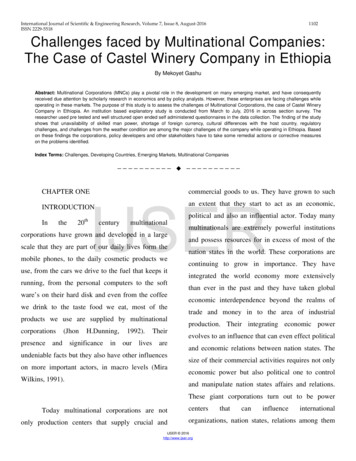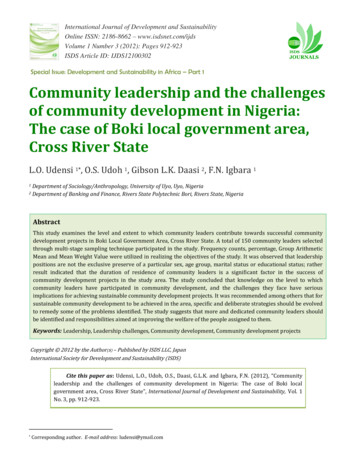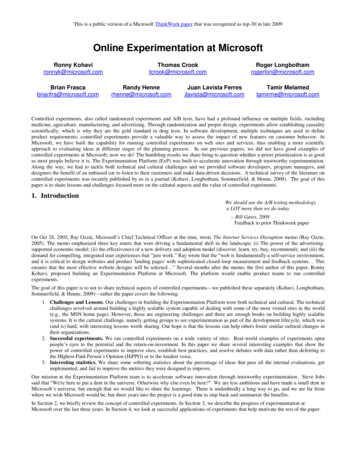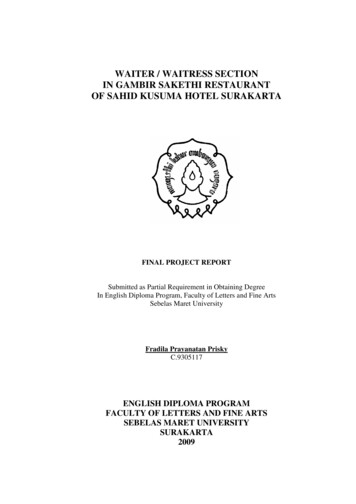
Transcription
Vol-5, Issue-2 PP. 54-60ISSN: 2394-5788CHALLENGES FACED BY COMMUNITY BASEDORGANISATIONS IN EMPOWERING WOMEN INRUDHAKA WEST DISTRICT OF MARONDERA,ZIMBABWEEdith KarimanziraLecturer in the Department of Peace,Leadership and Conflict Resolution in the Faculty of Applied Social Science, Zimbabwe Open The present qualitative research that employed phenomenology research design investigated challenges faced by Community BasedOrganisations in empowering women in Rudhaka West District of Marondera, Zimbabwe. Two participants consisting ten (10) menand ten (10) women were selected by means of opportunity sampling. In-depth open-ended face-to-face interview, observationmethods were used to generate data. Research data were presented descriptively in words. Findings were interpreted using thickdescriptions of phenomena derived from direct quotes and measured against similar previous research observations. Four key findingsemerged from the conduct of this study. These were; 1) Cultural barriers to gender equity and gender equality, 2) Increased femalehousehold chores, 3) Lack of capacity to manage programmes and projects, and 4). Unsustainable income generation activities. Fourconclusions emerge from the findings. First, cultural barriers-norms, values and traditions that women should be economically andsocially below men.This was also complemented by the information obtained from the key informants that although they try by allefforts to educate the women and also give her access to economic means culture and tradition still affects their progress. Second,increased burden-household roles, informal work mainly affects the programmes of the CBO, the informants mentioned sometimestheir members fail to turn up for duties or meeting citing burden of balancing househol responsibilities and the CBO responsibilities.Third, majority of the respondents and the key informants highlighted that since they are non profit making they get trainings fromonly interested partners interms of project management trainings hence they have limited experience in management of economicprojects and programmes. Fourth, though they are having projects to suppliment their household incomes it was also highlighted thattheir economic projects may be done for window dressing reasons, because they have low income generating capacity andsustainability. From the findings and conclusions, three recommendations suffice. First, there is need for CBOs to mobilise resourcesto enable them to empower women wherever they would be. Second, society needs to move away from cultural practices that denigratewomen if ever women are to contribute meaningfully to the development of their area on an equal footing with men. Third, moreresearch in the studied area needs to be conducted in order to conscientise the world on the fact that women have a place and key roleto play in developing their societies through CBOs.Key Words: Challenges, Community Based Organisations, women empowerment, community, organisation, women1. INTRODUCTIONWomen face diverse challenges which undermine the extent to which women get empowered. The community based organisationsstruggle to empowered disadvantaged women. Women are disadvantaged in terms of health with a high maternal mortality ratio at 96054 P a g e28 February 2018www.gjar.org
Vol-5, Issue-2Global Journal of Advanced Researchper 100,000 live birth, 18% females against 12% males were infected by HIV (ZIMSTATS, 2012). One (1) in 4 women reported thatthey had experienced sexual violence and 3 women aged 15 – 49 have experienced physical violence (ZIMSTATS, 2012). Incommunities there are cases of sexual and verbal abuse of women that are not reported due to patriarchal cultures and also religionbeliefs. Although laws recognise women as adults, cultural barriers still exist, that deny women access to political, social andeconomic freedom (Mapolisa and Chirimuuta, 2012; Mapolisa and Madziyire, 2012).Starting a CBO is generally much easier than sustaining it (Shredhar and Colaco, 1995) This explains why many CBOs have beenestablished and many have withered lost energy and disappeared (Joint United Nations Programme on HIV/AIDS, 1997). Like otherdevelopment actors CBO face challenges and these may stem from within the CBO itself such as weak leadership skills andinadequate resources while others may result from relationships with local or external organisations or from political-economic forces(Grown et al, 2005).Despite the fact that advocacy for women empowerment has been around for some time now, there are still myths andmisunderstandings about it that are rooted in cultural, traditional and religious beliefs and these may hinder collective action andreciprocity (Joint United Nations Programme on HIV/AIDS, 1997 :4). Women empowerment remains a largely misunderstoodphenomenon among people especially in Africa. This not only exacerbates suspicion, mistrust, fear and stigmatisation, but alsocomplicates community initiatives that are meant to address gender inequality (UN-OSAA 2003). These conflicting perceptions arecounterproductive and may dissuade community members from taking action against gender inequality. In the initial phase of theestablishment of CBOs cultural and traditional issues influences the level of participation in CBO activities among communitymembers. However, this has been overcome by intensive and continuous sensitisation and mobilisation efforts of the volunteers.As indicated earlier, the CBOs depend on volunteers. Most of them, like in most other CBOs have limited formal education with apaucity of skills in management as well as in information technology (Grown et al., 2006). This makes it very difficult for them tounderstand and interpret key national policies and strategies on women empowerment and to interpret information on funding options,which is normally written in English. Because of their limited literacy skills, the volunteers are not able to develop funding proposalsto the standards demanded by some donors. They also have limited skills in documenting their activities and reporting to the standardsexpected by partners and donors ((Joint United Nations Programme on HIV/AIDS, 1997 :5). This means that the CBO rarely capturesprogramming lessons, experiences, or successes. The lack of such vital programme information leads to re-inventing the wheel and awaste of scarce resources. In addition, the weak skills in documentation and the lack of an effective monitoring system further limitsprogression of the activities as there is no framework to capture change.In most cases when the CBO has to deal with information in English they have to rely on translation and interpretation by memberswho have proficient knowledge of English. This slows down the speed at which they can respond to such information and sometimes itis misinterpreted altogether. This has led to the CBO to miss out on various calls for funding and potential partnerships. In addition,there is very limited written information on the CBO because there are no structured monitoring activities of the performance of theCBO. Again, this is because of the poor literacy skills of most members and the lack of technology to manage information. Absenceand lack of ability to use technology such as computers and internet makes CBO member to function in an environment of hesitancy,wariness and isolation from what others are doing (UN-OSAA, 2003).As has been elaborated earlier, CBOs have limited resources. They therefore have to develop partnerships with other organisationsthat can provide resources. While external funding and support is essential among CBOs, dependency on donor funding creates asubstantial risk to the identity, autonomy and mission of CBOs (Barker et al., 2004). The donors and outside partners do not just giveresources; they also want to control the activities of the CBO to make sure that they are aligned with their interests. The erosion ofCBO autonomy could entail the CBO being expected to adopt the donor’s criteria for implementing and monitoring programmes,including using a logical framework and articulating results in complicated formats using western languages (UN/OSAL 2003: 46)which the CBO members are not familiar with. If this happens CBOs become more attuned and accountable to donors’ needs than tothe people they are meant to represent and serve (Social Worker Watch, 2005). “When the donor/CBO relationship is too close forcomfort, the latter risks losing the local innovative attributes that make it an attractive alternative to mainstream development” (SocialWorker Watch, 2005; UN-OSAL, 2003: 46).As with most CBOs, the Rudhaka District Community Development Trust (RDCDT) volunteers are local residents with no formalemployment and they must balance the time they spend volunteering with the time they need to spend on domestic chores to fend forthemselves and their families. The question of maintaining their motivation levels cannot be taken for granted particularly when theCBO offers no guarantee for rewards. During group discussions with CBO volunteers it was reviewed that after contributing to theCBO some volunteers expect some rewards from resources provided by donors (tokenism). When this is not forthcoming some feelfrustrated and leave. Volunteers also drop out due to pressures to contribute to household and livelihood chores, which sometimesrequire them to engage in paid labour in order to support their families (Joint United Nations Programme on HIV/AIDS, 1997). In thiscase the very fervent intrinsic motivation of the volunteers may result in individual agendas that if not well managed becomedetrimental to the CBO itself (Zaidi, 2005). The experience with the RDCDT CBO was that volunteers come and go but there arealways some, usually, pioneers who remain to maintaining the purpose and existence of the CBO.55 P a g e28 February 2018www.gjar.org
Vol-5, Issue-2Global Journal of Advanced ResearchIn most cases the formation of a CBO is spearheaded by either one person or a small group of people. As the CBO grows, morepeople join in and the demand for service increases. The pioneers usually want to continue leading the CBO activities but do notnecessarily have the skills to do so. Ideally the pioneers have to learn the skills (which in most cases they are not able to) or hirequalified people, or step aside for more qualified leaders to manage the CBO. Unfortunately, the pioneers are not always willing topass on responsibilities to newer and more able members (Joint United Nations Programme on HIV/AIDS, 1997: 2195). This is whatis called the founder syndrome. Another problem is that pioneers want to be rewarded more than other members simply because theyspearheaded the formation of the CBO. Though this is not outstanding with the CBO, discussions with some long term volunteersreviewed that they felt they deserve allowances and that they must have fulltime paying positions in the CBO. This has the potential ofcreating conflict within the CBO and could lead to collapse of the CBO if not well managed.In the light of the foregone challenges that militate against women empowerment, it remains for the researcher to explore the extentto which such findings obtain in Rudhaka West District of Marondera, Zimbabwe.2. METHODS AND TECHNIQUESI made use of the qualitative research approach to carry out this study. It enabled me to obtain data from the participants’experiences (Patton, 1990; Gray, 2009) based on challenges faced by CBOs in empowering women in Rudhaka West District ofMarondera, Zimbabwe. I used phenomenology research method to generate data on challenges faced by CBOs in empowering womenin Rudhaka West District of Marondera, Zimbabwe. Phenomenology enabled me to explore in great depth and detail (Punch, 2004)challenges faced by CBOs in empowering women in Rudhaka West District of Marondera, Zimbabwe. I employed opportunitysampling to select 20 participants, 10 males and 10 females. Opportunity sampling offers researchers benefits of making use ofinformants/participants with credible research sought knowledge (Marshall and Rossman, 2011; Patton, 2002). In-depth face-to-facepersonal interviews lasting at least thirty minutes helped me to generate comprehensive data (Saunders et al., 2012). This researchinstrument assisted the researcher to seek clarity and make probes on challenges faced by CBOs in empowering women in RudhakaWest District of Marondera, Zimbabwe, which could have been made impossible had I used the questionnaire (Black, 2010).Observation method also complemented in-depth interviews in data generation. As the researcher, I was able to see and tell how farwomen in Rudhaka West District were lacking empowerment opportunities in spite of the fact that CBOs were present and supposedto empower women. Both the interview and observation methods sought research data confined to challenges faced by CBOs inempowering women in Rudhaka West District of Marondera, Zimbabwe. In analysis data, I used thematic content analysis. Thematiccontent analysis, according to Silverman (2006), assists researchers to manage large volumes of data and be able to categorise findingsinto specific themes and sub-themes. Research data were then presented in words, rather than numbers since the research wasqualitative (Buchanan and Bryman, 2009). The interpretation of research findings was enriched by the use of direct quotes, field notesand previous research findings in the same area.3. RESULTS AND DISCUSSIONThe findings are presented in two sections descriptively, namely, research participants’ bio-data and actual research findings.Researcher Participants’ Bio-dataTwenty (20) participants took part in the study. Ten (10) of them were male, while the other ten (10) were female. Eight (8) of theparticipants were aged between 30 and 39 years, six (6) were aged between 40 and 49 years, while the other six (6) were aged at least50 years. Fifteen (15) participants were married, while three (3) were widowed and two (2) had never married. Ten (10) femaleparticipants were informally employed; and ten (10) male participants were employed as teachers (4), nurses (3), police officers (2)and veterinary officer (1). The choice informally and formally employed participants were deliberate in the sense that I would obtain across sectional multi-participant perspective of some of the possible challenges faced by CBOs in empowering women in RudhakaWest District of Marondera, Zimbabwe.Actual Research DataFour emerging themes from the study’s findings were:1.2.3.4.Cultural barriers to gender equity and gender equalityIncreased female household choresLack of capacity to manage programmes and projectsUnsustainable income generation activities56 P a g e28 February 2018www.gjar.org
Vol-5, Issue-2Global Journal of Advanced ResearchCultural barriers to gender equity and gender equalityWith reference to cultural barriers to gender equity and gender equality as one of the challenges faced by CBOs in empoweringwomen of Rudhaka West District in Marondera, here are some of the participants’ viewpoints:Culture which favours men makes us women access less empowerment opportunities. Our husbands do not feelfree to find us associating with men working for CBOs (P1).Men and women here are not treated equally. Men have better treatment culturally than women. Therefore, thelatter cannot work without problem with CBOs (P4).Women are not always forthcoming for CBOs’ projects and programmes because they tied down by regressiveculture that obtains in the district (P6)Females, according to our culture are supposed to be followers of males in terms socio-economic and politicalstatus. They should not be seen as equal competitors with men (P18).Although CBOs are supposed to empower women, cultural practices that degrade women defeat the whole processof empowering the marginalised and vulnerable women (P3).Culture obtaining in our area dictates that there is no better place for women other than the home. As a result ofthis misconception, CBOs’ cease to serve their purpose of empowering women (P16).CBOs are community based in their operation. They involve travelling and mixing with a lot of people of differentcharacters and behaviour. Therefore, men feel jealous of their spouses’ exposure to other men (P2).Women face diverse challenges which undermine the extent to which women get empowered. The community based organisationsstruggle to empowered disadvantaged women. Women are disadvantaged in terms of health with a high maternal mortality ratio at 960per 100,000 live birth, 18% females against 12% males were infected by HIV (ZIMSTATS, 2012). One (1) in 4 women reported thatthey had experienced sexual violence and 3 women aged 15 – 49 have experienced physical violence (ZIMSTATS, 2012). Incommunities there are cases of sexual and verbal abuse of women that are not reported due to patriarchal cultures and also religionbeliefs. Although laws recognise women as adults, cultural barriers still exist, that deny women access to political, social andeconomic freedom (Mapolisa and Chirimuuta, 2012; Mapolisa and Madziyire, 2012). In this study, culture has been perceived as a toolfor disempowerment of women.Increased female household choresRegarding increased female household chores as another challenge faced by CBOs in empowering women of Rudhaka WestDistrict in Marondera, selected participants had this to say:Most women fail to undertake CBOs’ activities because of an engagement with too many household chores, thatmen will never undertake (P11).Household chores deprive women of opportunities to participate in CBOs’ activities and other forms of formaleducation in search of empowerment (P15).Women are increasing confined to the home where they are delimited to household chores at the expense ofwomen empowerment through CBOs (P14).Household chores relegate women to poverty because of their limited and lack of access to CBOs’ activities andprogrammes (P12).Cultural beliefs overload women with domestic chores since the women are restricted to the home while men arefree to do as they please. In that way, empowerment of women is compromised (P19).The participation of women in CBOs’ activities, projects and programmes is hindered by heavily involving womenwith domestic chores which seriously impedes women empowerment (P20).Despite the fact that advocacy for women empowerment has been around for some time now, there are still myths andmisunderstandings about it that are rooted in cultural, traditional and religious beliefs and these may hinder collective action and57 P a g e28 February 2018www.gjar.org
Vol-5, Issue-2Global Journal of Advanced Researchreciprocity ((Joint United Nations Programme on HIV/AIDS, 1997 :4). Women empowerment remains a largely misunderstoodphenomenon among people especially in Africa. This not only exacerbates suspicion, mistrust, fear and stigmatisation, but alsocomplicates community initiatives that are meant to address gender inequality (UN-OSAA, 2003). These conflicting perceptions arecounterproductive and may dissuade community members from taking action against gender inequality. In the initial phase of theestablishment of CBOs cultural and traditional issues influences the level of participation in CBO activities among communitymembers. However, this has been overcome by intensive and continuous sensitisation and mobilisation efforts of the volunteers. Thus,women appear to enslaved in the home at the expense of their empowerment. This implies that women’s economic, social and politicalstatus remains at its lowest ebb. They are viewed as domestic workers, let alone, second class and inferior citizens when compared tomen.Lack of capacity to manage programmes and projectsWith regards to lack of capacity to manage programmes and projects as part and parcel of the challenges faced by CBOs inempowering women of Rudhaka West District in Marondera, some participants made the following substantiations:None of us women have the capacity to manage projects and programmes in the field. CBOs have a mammoth taskif they are to train women in management responsibilities (P9).Talk about project and programme management among women in this district. You will be luck to come across oneor two women who have been trained to manage projects (P11).Projects and programmes meant to empower women die a natural death due to lack CBOs’ capacity to trainwomen (P17).Although CBOs are around in the district, training opportunities in the areas of management of projects andprogrammes that empower women here are nought (P19).Training opportunities in the areas of project and programme management meant to empower women in theRudhaka West district are limited and irregular such that very few women benefit from the existence of CBOs (P8).Sporadic training opportunities by CBOs disempower women (P12).In the light of the aforementioned findings, CBOs are constrained resource-wise. The findings are compatible with three previousresearch observations. First, starting a CBO is generally much easier than sustaining it (Social Worker Watch, 2005). Second, thisexplains why many CBOs have been established and many have withered lost energy and disappeared (Joint United NationsProgramme on HIV/AIDS, 1997). Third, like other development actors CBO face challenges and these may stem from within the CBOitself such as weak leadership skills and inadequate resources while others may result from relationships with local or externalorganisations or from political-economic forces (Klassen, 2006). The researcher contends that availability of resources and strongleadership, as well as political will would make CBOs accomplish their goal to empower women.Unsustainable income generation activitiesWith respect to the existence of unsustainable income generation activities as the other challenge faced by CBOs in empoweringwomen of Rudhaka West District in Marondera, participants perceived the following:Apart from market gardening and chicken rearing, income generating projects and programmes here areunsustainable (P2).CBOs have to dig very deep in order for them to come up with sustainable income generation projects that havethe capacity to empower women in this district (P7).Starting capital for income generation projects spearheaded by CBOs is a teething challenge because financialinstitutions do not release money for such projects on a silver platter (P9).Lack of responsiveness by women in the district to income generation projects makes such projects appearunviable and unsustainable (P10).The implication of the preceding findings is that CBOs tend to have limited resources that enable them to capacitate women.Therefore, the research findings bode well with the following three previous research findings. First, they therefore have to developpartnerships with other organisations that can provide resources. While external funding and support is essential among CBOs,58 P a g e28 February 2018www.gjar.org
Vol-5, Issue-2Global Journal of Advanced Researchdependency on donor funding creates a substantial risk to the identity, autonomy and mission of CBOs (Lopez-Carlos and Zaidi,2005). Second, the donors and outside partners do not just give resources; they also want to control the activities of the CBO to makesure that they are aligned with their interests. The erosion of CBO autonomy could entail the CBO being expected to adopt the donor’scriteria for implementing and monitoring programmes, including using a logical framework and articulating results in complicatedformats using western languages (UN/OSAL 2003: 46) which the CBO members are not familiar with. Third, if this happens CBOsbecome more attuned and accountable to donors’ needs than to the people they are meant to represent and serve (Social WorkerWatch, 2005). Fourth, when the donor/CBO relationship is too close for comfort, the latter risks losing the local innovative attributesthat make it an attractive alternative to mainstream development (Social Worker Watch, 2005; UN-OSAL, 2003: 46). On the basis ofthese findings, it can be deduced that resources are critical in enabling CBOs to empower women wherever they are.4. CONCLUSIONS AND RECOMMENDATIONSFour conclusions emerge from the findings. First, cultural barriers-norms, values and traditions that women should beeconomically and socially below men.This was also complimented by the information obtained from the key informants that althoughthey try by all efforts to educate the women and also give her access to economic means culture and tradition still affects theirprogress. Second, increased burden-household roles, informal work mainly affects the programmes of the CBO, the informantsmentioned sometimes their members fail to turn up for duties or meeting citing burden of balancing househol responsibilities and theCBO responsibilities. Third, majority of the respondents and the key informants highlighted that since they are non profit making theyget trainings from only interested partners interms of project management trainings hence they have limited experience in managementof economic projects and programmes. Fourth, though they are having projects to suppliment their household incomes it was alsohighlighted that their economic projects may be done for window dressing reasons, because they have low income generating capacityand sustainability.From the findings and conclusions, three recommendations suffice. First, there is need for CBOs to mobilise resources to enablethem to empower women wherever they would be. Second, society needs to move away from cultural practices that denigrate womenif ever women are to contribute meaningfully to the development of their area on an equal footing with men. Third, more research inthe studied area needs to be conducted in order to conscientise the world on the fact that women have a place and key role to play indeveloping their societies through CBOs.REFERENCES[1] Barker, G., Nascimento, M., Segundo, M. and Pulerwitz, J. (2004) „How Do We Know if Men[2] Have Changed? Promoting and Measuring Attitude Change with Young Men: Lessons from Program H in Latin America‟,in Ruxton, S. (ed.). Gender Equality and Men: Learning from Practice, Oxford: Oxfam.[3] http://www.oxfam.org.uk/what we do/resources/downloads/geneqmen/gem barker.pdf[4] Black. K. (2010). “Business Statistics: Contemporary Decision-making” (6th edition). London: John-Wiley and Sons.[5] Buchanan, B. A., and Bryman, A. (2009). The Sage Handbook of Organisational Research Methods. London: Sage.[6] Gray, D. E. (2009). Doing Research in the Real World (2nd Edition). London: Sage Publications.[7] Grown, C., Rao Gupta, G. and Kes, A. (2005). Taking Action: Achieving Gender Equality and Empowering Women, UNMillennium Project Task Force on Education and GenderEquality, London and Sterling, VA: ents/Gender-complete.pdf .[8] Joint United Nations Programme on HIV/AIDS. (1997). UNAIDS Progress Report: 1996-1997. California, University ofCalifornia.[9] Klasen, S. (2006) „UNDP‟s gender-related measures: some conceptual problems and possible solutions‟, Journal of HumanDevelopment 7 (2), 243–74.[10] Lopez-Claros, A. and Zahidi, S. (2005). Women’s Empowerment: Measuring the Global Gender Gap, Geneva: WorldEconomic Forum.http://www.weforum.org/pdf/Global Competitiveness Reports/Reports/gender gap.pdf[11] Mapolisa, T. and Chirimuuta, C. (2012). Open and Distance Learning: An alternative university education for women at theZimbabwe Open University. International Women Online Journal of Distance Education, 1(1), 1-14.59 P a g e28 February 2018www.gjar.org
Vol-5, Issue-2Global Journal of Advanced Research[12] Mapolisa, T. and Madziyire, N.C. (2012). Female Leadership Dilemmas in Primary Schools: A Case Study of 18 PrimarySchools in Kambuzuma, Warren Park and Kuwadzana Areas of Harare Province in Zimbabwe. International J. Soc. Sci. &Education, 2(3), 447-460.[13] Marshall, C., and Rossman, G. B. (2011). Designing Qualitative Research. Thousand Oaks: Sage Publications.[14] Social Watch. (2005). No Country Treats its Women the same as its Men: The Gender Equality Index –a New Perspective‟,in Social Watch Roars and Whispers: Gender and Poverty: Promises Versus Action, Montevideo: Social /pdfs/gei2005 eng.pdf[15] Patton, M. Q. (1990). Qualitative Evaluation and Research Methods. London: Sage Publications.[16] Patton, M. Q. (2002). Qualitative Evaluation and Research Methods. London: Sage Publications.[17] Punch, K. F. (2004). Introduction to Social Research. Quantitative and Qualitative Approaches. London: Sage.[18] Silverman, D. (2006). Interpreting Qualitative Data (3rd Edition). London: Sage.[19] UN-OSAA. (2003). Community Realities and Responses to HIV/AIDS in Sub-Saharan Africa. New York, United Nations.[20] UNOSAL. (2003). UN Observer Mission in El Salvador; Monitored Human Rights during Peace Process.[21] ZIMSTATS, (2012), Zimbabwe Men and Women Report 2012. Zimbabwe National Statistics Agency. Harare, Zimbabwe.60 P a g e28 February 2018www.gjar.org
Women face diverse challenges which undermine the extent to which women get empowered. . phenomenon among people especially in Africa. This not only exacerbates suspicion, mistrust, fear and stigmatisation, but also . Zimbabwe. Phenomenology enabled me to explore in great depth and detail (Punch, 2004) challenges faced by CBOs in empowering .










